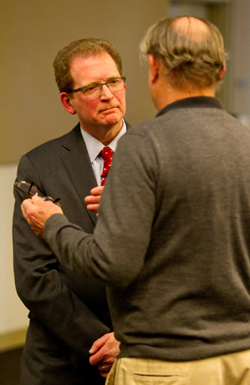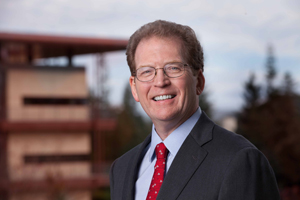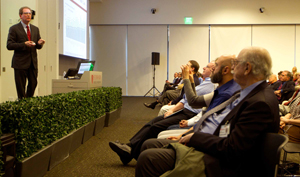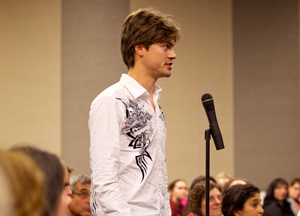February 11, 2013 - By Susan Ipaktchian
As an otolaryngologist, Lloyd Minor, MD, knows a thing or two about ears. And right now, his are getting a full-time workout.
Take the afternoon of Feb. 5. Minor, who became the dean of the School of Medicine on Dec. 1, held a town hall meeting attended by more than 500 faculty, staff and students. Minor invited them to "begin a dialogue with me about where we are and where we need to go in the future."
He outlined and discussed what he sees as the three key priorities of the school: advancing innovation, empowering future leaders and transforming patient care. He then invited the attendees to share their thoughts with him.
The future was very much on their minds, judging from the questions they asked - questions ranging from the uncertainties surrounding federal research funding, to ways of making careers in primary care medicine professionally and financially rewarding, to the path ahead for students and trainees.
Video profile of Lloyd Minor, MD. Length: 10 min
Antoine de Morree, PhD, co-chair of the Stanford Postdoctoral Association, told Minor he liked the concept of empowering future leaders, but noted that most postdocs will have a tough time landing a faculty job in the field they care about most deeply.
Minor acknowledged that academic jobs will likely remain scarce in the next few years. "But don't let that discourage you — or at least, don't let it discourage you too much — because you're training at absolutely the finest place on Earth. You really are," Minor told de Morree. "If you continue to hold the same passion and enthusiasm and dedication to your work, then you're going to succeed."
In a recent interview, the new dean said he places high value on listening to the hopes and concerns of those he serves. Since leaving his previous position as provost of Johns Hopkins University at the end of August, he has been at Stanford meeting with a variety of people to better understand the issues facing the School of Medicine.
"I think one of the most active things that I do is to listen and process what I'm hearing, and to come up with informed questions that bring us together in planning our future," Minor said. "That is what I am engaged in now."
It's just the kind of approach that Bill Brody, MD, PhD, the former president of Johns Hopkins and a Stanford University trustee, would expect from Minor. "He's a very good strategic thinker, and he will analyze a situation and look at all the options before deciding how to proceed," Brody said.
--------
Minor's childhood experiences shaped his outlook and values. He grew up in Little Rock, Ark., amid the tumultuous efforts to desegregate public schools and enforce civil rights in the South. Minor experienced first-hand the disparities in educational opportunities when he was bussed to a previously all-black junior high school.

Lloyd Minor, dean of the medical school, speaks with a member of the audience after a town hall meeting Feb. 5. "I think one of the most active things that I do is to listen and process what I'm hearing," he said.
His interest in otolaryngology took root during an undergraduate bioengineering class at Brown University that took as a model the vestibular system in the inner ear, which helps us sense motion and maintain balance. The opportunities to help patients suffering from balance and hearing problems as well as conduct research to better understand such disorders cemented his decision to specialize in the field.
As a medical student, resident and research fellow, Minor consistently sought ways to broaden the scope of his work.
Kathleen Cullen was doing her PhD work in neurobiology at the University of Chicago and was sharing lab space with Minor, who was doing his postdoctoral research fellowship there. "My first week with the group, we had a little difference in opinion about a maze of wires running through the lab, and I may have approached Lloyd in a less than collegial manner about the problem. Even at that point in his career, he was good at managing crisis situations," she said with a laugh
Minor and Cullen quickly became collaborators and friends, a relationship that continues to this day. They even played together on Chicago's Committee on Neurobiology "Mind Over Batter" softball team. "He's not a particularly good softball player and we weren't a great team, but he was a regular," Cullen recalled.
Their scientific collaboration continued for the next 20 years as they investigated the physiology of vestibular function. "I had trained as an engineer and he had a clinical background, and he gave me a greater appreciation for the clinical impact of my work," said Cullen, who is now a professor of physiology at McGill University in Montreal and directs the aerospace medical unit there.
Minor helped to make Cullen feel comfortable at a time when female neuroscientists were still relatively rare. "Chicago was very male, and Lloyd made the environment in the group very collegial for me," she said. "Lloyd let me do surgery on one of his animals, and it gave me a lot of confidence that I could master this skill. He's very good at giving people wings to fly — seeing what they're capable of and letting them demonstrate that."
He completed his training, eventually moving to a faculty position at Johns Hopkins in 1993. Several years later, Minor saw a patient with an unusual complaint: Loud noises made him dizzy. Later he would see other patients with related complaints, such as hearing the sound of their own voice as disturbingly loud. Through both his work with patients and his research, he made groundbreaking discoveries by identifying the problem as a tiny opening in the bone overlying an inner-ear balance canal. Minor named the condition superior canal dehiscence syndrome, and developed a method of diagnosing the problem as well as a surgical procedure to essentially plug the opening in the tiny bone.
"It's widely acknowledged that his work changed the field," said Robert Jackler, MD, professor and chair of otolaryngology at Stanford. [More information about Minor's research and superior canal dehiscence syndrome, is available at http://lane.stanford.edu/deansresearch/index.html.]
The painstaking microsurgery near the patient's brain requires precision and sure hands; the procedure is now performed on thousands of patients by surgeons who have trained in the subspecialty of neurotology. For those who have suffered from the debilitating effects of the syndrome, the treatment is life-altering.
--------

Minor, an otolaryngologist and former provost of Johns Hopkins University, became dean at the School of Medicine on Dec. 1.
Groggy from surgery, Cindy Hirsch closed her eyes. She no longer heard noise as she moved her eyeballs from one side to the other, and immediately knew that she was cured.
Since that day seven years ago, she sends a thank-you note to Minor every February on the anniversary of her surgery.
"He saved my life," said Hirsch, a doctor of audiology in Atlanta. "The quality of my life was horrendous. I could not function. Now, I'm normal, I'm normal, I'm normal."
Hirsch was the 34th patient Minor treated for superior canal dehiscence syndrome. She remembers the moment when it hit her. While attending a conference on April 17, 1997, in Fort Lauderdale, Fla., she walked into a party where a band was playing loudly. Suddenly, the band members seemed to be dancing sideways, "like they were doing the cancan," Hirsch recalled. Feeling violently dizzy and nauseated, she walked to the back of the room.
An opening had developed in the tiny bone overlying her inner ear. She believes the bone may have already been thinning, and the loud noise that evening "sent me over the edge."
In the months and years afterward, Hirsch remained highly sensitive to the faintest noise. Even hearing the dishes clink as she washed them "made me want to throw up." She began wearing earplugs when she went to watch her children play sports or perform in auditoriums. "You know when you go to a concert your head feels full and your ears ring? Well, that's what happened to me every single day," Hirsch said.
The bouts of dizziness and the constant cacophony in her head left her exhausted. She said she became something of a hermit, and realized she was missing out on important activities in her children's lives. None of the doctors she consulted could pinpoint her problem.
Then she read a paper by Minor about superior canal dehiscence syndrome and was sure she had it. After contacting him and getting the highly sensitive CT scan he needed, she eventually journeyed to Hopkins for a consultation where "in two seconds he diagnosed me," she said.
After a thorough round of testing, Minor discussed the risks of the surgery with Hirsch and her husband. "He's very careful in picking his patients, which I honor and respect," she said.
Comforted by Minor's empathetic manner and the quality of his published research, Hirsch went ahead with the surgery. A scant two months later, Hirsch had rejoined the world, painting her living room and dining room and returning to work. "Now, I'm cured," she said.
Hirsch expressed disappointment that more patients won't benefit personally from the compassionate care she received from him.
"But if anything ever happens to my other side — not that there's any indication that it will — I'm calling him at home," Hirsch said with a laugh. "I will show up at his doorstep at Stanford."
--------

Minor answers questions from attendees during a Feb. 5 town hall meeting at the Li Ka Shing Center for Learning and Knowledge.
In 2003, Minor was appointed chair of the Department of Otolaryngology-Head and Neck Surgery and otolaryngologist-in-chief at Johns Hopkins Hospital. Brody, who was then the university president, characterized the department as "very distinguished, but not performing up to its potential" prior to Minor's appointment as chair, and so he was curious to see how Minor would respond to the challenges. Brody said he was struck by Minor's ability to "run silent, run deep," — quietly listening and devising his plans.
"He has a fortitude that is very focused," Brody said. "He took the department to new highs in its research performance, clinical outcomes and financial outcomes." Under Minor's leadership, the department achieved a 50 percent expansion in research funding and a 30 percent increase in clinical activity.
Ronald Peterson, president of The Johns Hopkins Hospital and Health System and executive vice president of Johns Hopkins Medicine, said that while Minor built clinical service volumes and quality in otolaryngology, "he will be best remembered for bringing the science in the department to the next level. At the same time, he was extremely attentive to the fiscal affairs of the department and left it in very good condition on his departure."
In addition, Minor wanted to address the lack of women on the faculty. Sandra Lin, MD, an associate professor of otolaryngology, said, "At the time, I was the only female clinical faculty member on the main campus in our department, and there was one other female clinical faculty member at the Bayview campus."
Minor asked Lin to head the department's diversity and inclusion efforts. They created a committee and began talking with faculty members to identify the barriers and devise remedies. "We found out that a lot of things that were important to women were important to men on the faculty as well, but everyone had been afraid to speak up," Lin said. Many of these issues fell in the area of balancing work and home responsibilities, such as being able to attend their children's school or sporting events in the evenings.
"Our department used to have meetings after the end of the business day, and that systematically excluded people who had evening responsibilities outside of work," Lin said. "Right away, Lloyd moved our department meetings so that they took place early in the day, which the faculty collectively felt would be a more manageable time in order to balance work and outside responsibilities."
The department implemented mentorship programs, actively recruited women and underrepresented minority faculty in both the clinical and research ranks, and added a clerkship that was available to minority medical students interested in doing an otolaryngology rotation at Johns Hopkins Hospital.
One result was that the number of female clinicians and basic scientists in the 36-person department grew from three to nine under Minor's leadership. Three were promoted to associate professors by the time he became provost. Those efforts have continued to bear fruit; Lin said currently about 40 percent of the department's residents are women, as are one-third of its faculty.
"Lloyd is a person of action and results. He really wanted change," Lin said.
--------

Antoine de Morree, co-chair of the Stanford Postdoctoral Association, tells Minor about his concern for postdocs' job prospects.
While chairing the otolaryngology department, Minor also expressed an interest in working more broadly on university-wide initiatives. Although Brody had left the university in 2008 to become president of the Salk Institute for Biomedical Research, he recommended that Hopkins consider Minor as a candidate for provost in 2009, and the two men spoke frequently by phone after Minor got the job.
"I wasn't sure how someone from otolaryngology would take to dealing with the classics department, the applied physics department, the philosophy department," Brody said. "I was really astounded at how quickly he grasped not only the vernacular and the strategic issues, but also the local cultural ethos and the peculiarities of various parts of the university. As provost and in his own research and clinical work, Lloyd was highly integrative and interested in bringing together various disciplines."
In addition to overseeing the university's nine schools and leading its budgeting process, Minor reinforced and expanded the university's efforts to recruit and retain a diverse faculty. He also bolstered the university's educational efforts, implementing programs to increase student satisfaction and to enhance introductory science courses at the undergraduate and graduate levels. He led the development of a board to promote excellence in doctoral education.
Perhaps one of his greatest accomplishments was providing opportunities and incentives to draw the university's nine schools closer together, said Jonathan Bagger, PhD, the vice provost for graduate and postdoctoral programs who is currently serving as interim provost.
"Historically, Johns Hopkins has had a low-profile and reactive provost's office. When Lloyd arrived, he set out to change that, with the support of the president," Bagger said. "He was constantly finding ways to use his position to engage faculty from across the university – both with the central administration and with each other."
For example, he created a fellowship program in the provost's office in which faculty members spend 20 percent of their time working on projects they've proposed. One such project involved improving premedical education for undergraduate students and strengthening efforts to recruit and retain premedical students from minority groups. Another involved developing social-networking tools to better connect faculty and students.
"I appreciate the dialogue he sparked with the faculty," Bagger said, adding that his admiration for Minor has increased since temporarily taking on the provost's duties. "In a job like this, where so many issues come across the desk, what really matters are one's values. A lot of these issues don't have clear answers, and there isn't always time to research every angle. What it comes down to is the person's values — and Lloyd's are impeccable. His commitment to integrity, both personal and institutional, is extraordinary."
--------
After Philip Pizzo, MD, announced that he would be stepping down as dean of Stanford's medical school after 12 years, Minor learned about the opening and was intrigued by the possibility. Though he had spent most of his academic career at Johns Hopkins, he recognized that the two institutions both were respected internationally for their emphasis on interdisciplinary research and on strong relationships between basic science and clinical care.
"One thing Stanford has done exceptionally well is drawing bridges across disciplines," said Alan Garber, PhD, who was a professor of health research and policy at Stanford until moving to Harvard to become provost in 2011. The two men got to know each other as fellow provosts, and Garber said he believes Minor's background will serve him well at Stanford.
"At Hopkins, he moved from being a successful researcher in one field of medicine to being a department chair to having to think about a wide range of issues for the whole university," Garber said. "That kind of experience makes you think of the academic enterprise as a whole in a different way."
After accepting the position of dean last summer, Minor spent the fall months at Stanford, getting better acquainted with the people and the issues before officially taking over on Dec. 1.
Sam Gambhir, MD, PhD, professor and chair of radiology, was co-chair of the search committee for the new dean. In the early weeks of Minor's administration, Gambhir said he already has noticed that Minor "spends most of the time listening to others, synthesizing the information and then verbalizing well-thought-through next steps. It is just terrific to see him listen to many different important and sometimes divergent perspectives."
Given the uncertainties over research funding and health-care reimbursements, angst and gloom wouldn't be out of place on most medical school campuses these days. But Minor said he hasn't encountered them at Stanford. If anything, he has been struck by the enthusiasm.
"There is a spirit of transformative innovation and a tradition of paradigm-shifting research here. It's part of the Stanford secret sauce," he said. "Every day I'm impressed by the quality of the people here and by the collective optimism in the environment. It's very refreshing."
The current fund-raising campaign, with a proposed $2 billion goal, for the medical school and Stanford Hospital is an opportunity to frame discussions around future goals, Minor said. "We have this window in time where the Campaign for Stanford Medicine is very much on everyone's radar at the university level and in our community. We want to make sure that we're using that opportunity to help us focus our thoughts on the future, and what we need to make the future reality."
Among Minor's initial areas of focus is working with faculty members to establish priorities for the campaign and also trying to determine how best to align the faculty tracks with the shared mission of the medical school and Stanford's two hospitals. "We need to look at how we recognize and reward excellence in all areas of our mission," said Minor.
Also high on Minor's list is bolstering the school's clinical programs. "We need to make sure that we are affirming to our faculty that we value patient care, just as we value research and teaching," Minor said. "Continuing to move the dial on clinical excellence and outstanding service to our patients and always putting our patients first in every care environment is something we are all very deeply engaged in."
The leaders of Stanford's hospitals said they are pleased that Minor wants to continue the medical school's commitment to high-quality patient care.
"As the academic children's hospital at Stanford, it is critical that we not only provide leading-edge care but also fully participate in the discoveries of tomorrow and the training of future leaders in pediatric and obstetric medicine," said Christopher Dawes, president and CEO of Packard Children's Hospital. "It is because of our relationship with the Stanford School of Medicine and the university that we are able to fulfill our mission at Packard Children's, which is to be innovators in the way that we provide care for our patients. Lloyd understands the importance of the intersection of academics and clinical care. He is clearly committed to the success of the medical center."
Amir Dan Rubin, president and CEO of Stanford Hospital & Clinics, said, "We have these incredible faculty members who have the vision and maybe the lack of fear to ask the big questions: How can we use stem cells? How can we train the immune system to fight disease? I think these attributes — discovery and innovation and compassion and a desire to heal humanity — are interlinked. What I get very excited about is that Lloyd truly sees that as well. And to that end, it's not just being new and innovative, but doing a great job for the patient experience."
While Minor speaks often of his hopes for strengthening the clinical care component of the medical school's mission, Daniel Herschlag, PhD, senior associate dean for graduate education and postdoctoral affairs and professor of biochemistry, said Minor clearly respects and supports the school's accomplishments in basic science.
"Basic research is now facing enormous challenges, especially to innovation and training the next generation of leaders and innovators," Herschlag said. "Lloyd has immediately stepped forward to help Stanford get ahead of these problems and to improve on our already fabulous research and training."
Lucy Shapiro, PhD, professor of development biology, added, "He has had an incredible career as a physician, as a basic scientist and as an educator, serving as provost at a very great university, Johns Hopkins University, so that he has the experience of dealing with people from many parts of our campus."
--------
Despite the many challenges facing academic medicine today, Minor is undaunted. "As a leader, sometimes you have to make tough choices," he said. "Addressing challenges head-on — and taking advantage of the opportunities they present — is the only way that we as an institution can move forward."
He is planning more town hall meetings like the one on Feb. 5, in addition to meeting with a variety of faculty, staff, students, donors and other constituents as he continues to work with his leadership team to formulate his plans for the future of Stanford Medicine around his priorities of advancing innovation, empowering future leaders and transforming patient care.
It's the same methodical process that has served him well throughout his career, and one that he believes will ensure that the medical school is firmly on the right track.
"A year from now, if we are moving forward with a number of priorities we have identified from our campaign planning process, if we are seeing our clinical programs strengthened, if we are collectively building the vision and the reality of Stanford Medicine in a way that integrates our clinical programs with our educational mission and our basic research — if we are moving forward on all those fronts, that will have been a successful year," Minor said.
About Stanford Medicine
Stanford Medicine is an integrated academic health system comprising the Stanford School of Medicine and adult and pediatric health care delivery systems. Together, they harness the full potential of biomedicine through collaborative research, education and clinical care for patients. For more information, please visit med.stanford.edu.